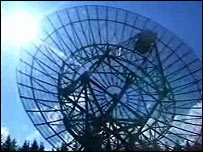AlbertPacino
Skilled

Using a network of radio antennae across the Netherlands and Europe's most powerful supercomputer, scientists hope to unlock the secrets of the early universe.
The Orion Nebula is a boiling belt of hydrogen and space dust that is a nursery for stars.
It is 1,500 light years away, which is just around the corner for astronomers.
Orion is just about visible with the naked eye, but if you want to look beyond our own neighbourhood you will need a radio telescope.
At the Netherlands's Foundation for Research in Astronomy, or Astron as it is known, there are 14 giant radio telescope dishes. Despite their size, they can still only study nearby galaxies.
If astronomers really want to unlock the secrets of the Universe's early history, they need to look even deeper into space.
So Astron's Lofar project is working on doing just that.
Director of the project Dr Eugene De Geuss-Astrong explains: "With the kinds of telescopes we are building now, we are able to detect signals that are so faint that the radiation has taken such a long time to get to us here on Earth that the amount of time is sort of similar to the age of the Universe."
Size matters
Radio telescopes operate by detecting the radio waves that all matter emits.
Conventional parabolic telescopes work in teams and the information from each is then patched together to give astronomers a complete picture of what is out there.
However, to reach the far end of the universe would require a telescope 100 times the size of conventional dishes.
Instead, scientists working on the Lofar project have resorted to pyramid power, creating 20 to 25,000 simple pyramidal radio antennae, which are being put in place 350 kilometres across the north of the Netherlands.
In the end they will go to make up the world's largest radio telescope.
Dr Eugene De Geuss-Astrong explains: "Size is extremely important in astronomy. The bigger you make the aperture that you look at the universe with, the sharper the images are.
"Basically these things, these radio dishes, almost act like rain collectors, so the bigger you make them, the more rain falls in.
"With a radio antenna it is exactly the same. We are looking for extremely weak radio signals from the universe, so if you make the antenna bigger, you collect more radiation."
This massive cluster of radio antennae does not, on its own, make a telescope.
The antennae merely produce the raw data, which is piped across an enormous fibre-optic network and then processed by Stella, Europe's most powerful supercomputer.
It is only through Stella's programs that these scrambled signals from space can be deciphered and turned into something useful.
The scientists describe what they have created as a software telescope. This high volume data processing is streaming computing.
The University of Gonungen's Professor Koos Duppen says: "Around the contents of 100 CDs per second arrives here. There is no storage medium where we can put that so we have to do calculations on this data while they come in."
Potato watch
The ability to process instantaneously large quantities of streaming data also has a number of commercial spin-offs, such as agriculture.
Thanks to remotely placed sensors, farmers can micro-manage and get the most from their crops.
As with Lofar's radio antennae, such wireless sensors which detect humidity and temperature paint a picture - not of the early development of our universe but the likely onset of potato blight or phytophthora.
Scientific director of the Lofar Project Joris Van Enst says: "On the screen of your computer it shows a map of your crop field and it really indicates the spots where the chances are really high, above a certain level, where there might be a phytopthora outburst.
"So a farmer can spray only on that spot, so he saves time. He saves money because he does not need so much poison, and he saves nature and the environment. In one sweep he also enhances the quality of the potatoes."
The possibilities for this sort of remote sensor system are endless.
Astron is already talking about using sensors for making underground geological maps and movies.
It is also possible that weather monitoring will become so localised and instantaneous that weather forecasting will become "now-casting".
Source

